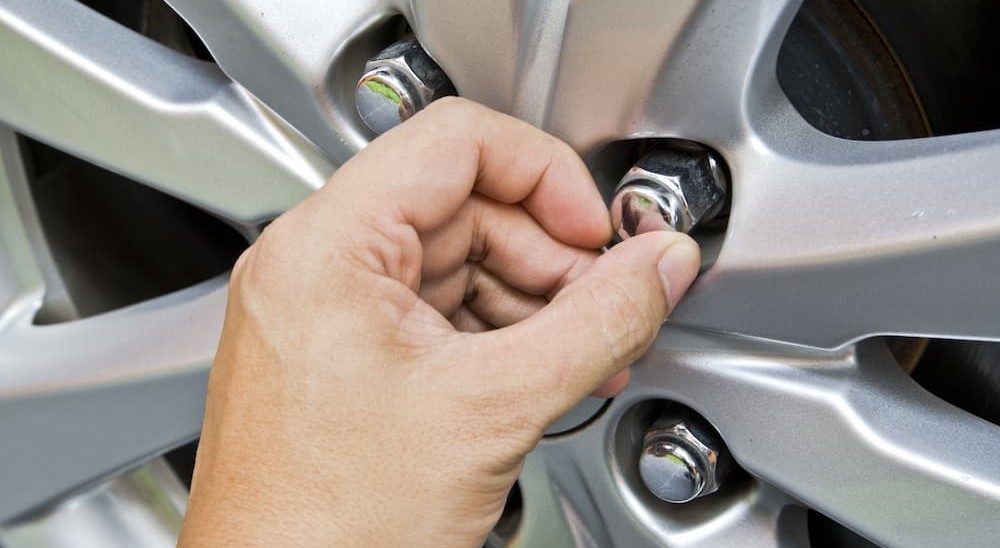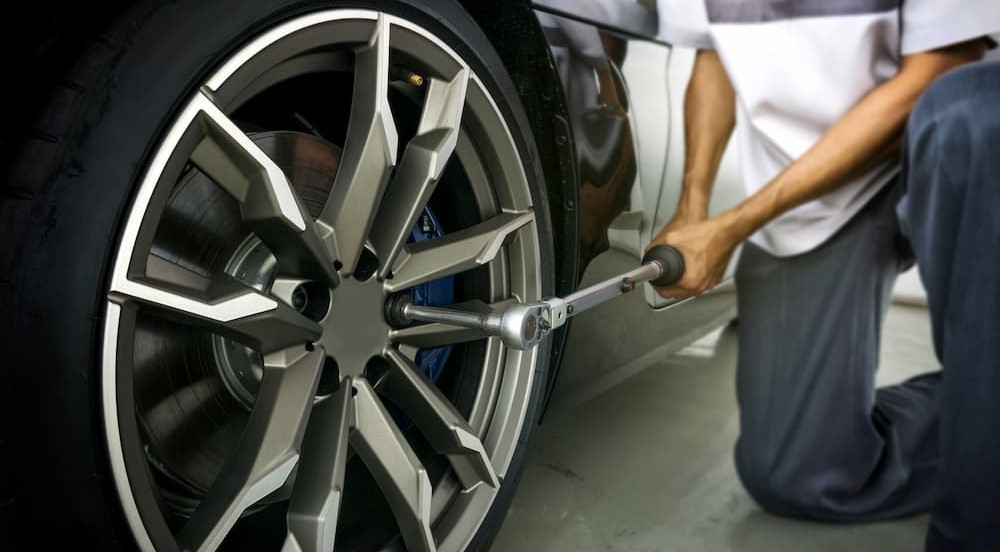If you’ve ever assembled an Ikea couch or any other flat-pack furniture, you might have completed the project only to be left with a few surplus nuts and bolts. In many cases these extra bits of hardware are purposely included as a backup, but they can still have you re-reading the inscrutable instructions and trying to figure out which step you missed. In most cases, finishing a project with a few extra parts is no cause for concern, but that doesn’t hold true when it comes to installing your tires. Your couch might be a marvel of modern Swedish design, but it’s also not regularly tasked with speeding down the highway at 70 mph. This is why it’s so hard to understate the importance of lug nuts.
As the sole thing responsible for keeping your wheels attached to your vehicle, lug nuts play a vital role in safety and performance. Not all lug nuts fit all vehicles, which is why it’s so important to ensure you reach for the right set the next time you switch out your winter tires or upgrade to a new set of wheels. From lug nut size, shape, and style to different lug nut seat types, let’s see how lug nuts differ and which version is the right choice for your particular make, model, and driving style.
Do All Lug Nuts Fit All Wheels?
While they might look pretty similar from a distance, lug nuts actually come in all shapes, sizes, and styles. There are five main characteristics to keep in mind when trying to find the perfect match: thread size, thread pitch, seat type, other dimensions, and finish/color. Let’s break down each of these terms and discover just how much of a difference each factor can make.
Thread Size
Thread size is probably the most basic measurement of any lug nut. The term, which describes the length of the wheel stud’s outside diameter, is often expressed in either standard or metric sizes like 7/16”, 1/2”, 10mm, 12mm, and 14mm, ranking among the most common. The ideal lug bolt diameter can be found in your owner’s manual but can also be gauged in a more tactile manner with a quick trip to your local hardware store. Simply find the section containing bolts and try attaching the lug nut to various sizes until you find the perfect fit.
Thread Pitch
Thread pitch is basically the density of the threads on a wheel stud. It is expressed in two very different ways depending on whether you’re using standard or metric. When dealing with standard sizes, thread pitch is described by the number of threads per inch and will typically range between 18 and 20. In metric applications, thread pitch is based on the distance between each individual thread as expressed in millimeters, with 1.25, 1.5, and 2.0mm being some of the most popular. While thread size is usually considered the most important attribute when finding the right lug nuts, thread pitch plays an equally significant role. If a wheel stud’s pitch is too small for a lug nut, it can result in a loose connection that could prove disastrous down the road. If it’s too large, you might struggle to make it fit. Even if you manage to squeeze it in, it could present some problems when it comes time to uninstall, as the two pieces of hardware almost become fused together when different pitches get cross-threaded.
Seat Type
The seat is the part of the lug nut that presses up against the wheel itself. Lug nuts are designed for a variety of seat types, and each is made to fit into a certain type of wheel. Tapered/acorn, mag, and ball seats tend to be the three most common designs, but flat seats, ultra-tapered mag seats, and other designs can also be found on some specialty models. Choosing the right seat type not only improves the overall aesthetic of your lug nuts but also serves an important safety role as it ensures a more secure connection. We’ll get into some specifics around seat types when we dive into different lug nut designs below.
Other Dimensions
Seat type covers the specific shape of the lug nut where it meets the wheel, but length and dimensions are two other measurements that a driver should keep in mind when trying to find the perfect fit. Diameter and outside length tend to be the two most important dimensions to keep in mind, though when it comes to mag-style nuts, shank diameter and depth must also be considered.
Finish and Color
Finally, there’s finish and color. While these are obviously rather cosmetic considerations, they can go a long way when it comes to crafting a stylish look for your vehicle. Chrome-plated, stainless steel, and zinc are some of the more popular colors and finishes, but those looking to set their ride apart from the crowd might consider getting a little flashy with black chrome, yellow chromate, or other eye-catching hues.

Lug Nut Seat Types
As mentioned above, there are many different ways that lug nuts can seat against a wheel and hold it in place. Let’s take a closer look at the different seat types that lug nuts can have.
Conical
Conical seat lug nuts, also known as acorn lug nuts, are the industry standard and can be found on a wide variety of vehicles. These lug nuts are recognizable for their inward taper, which usually measures around 60 degrees. This inward taper helps to center the lug nuts as they’re tightened, making for an easy, consistent fit. Until recently, these conical lug nuts were even used in some of the world’s top motorsports leagues, including NASCAR.
Ball Seat or Spherical
Ball seat/spherical lug nuts are similar to conical designs but employ a more rounded design. Like conical seat lug nuts, ball seat/spherical lug nuts help to center the lug nut as it’s tightened, making it another popular choice among some of the industry’s bigger names. While lug bolts are the go-to choice of many European brands, ball seat/spherical lug nuts are often a close second.
Flat
If you’ve ever struggled to center or unscrew a wheel, chances are a flat seat lug nut was to blame. Designed with a built-in washer, these lug nuts are notoriously difficult to center as the flat seat and washer can catch on the edge of the hole. This can trick a driver into thinking the lug nut is tightened, leading to all sorts of problems that could have you tightening and untightening lug nuts all afternoon. These lug nuts can also be difficult to remove, so they’re typically found on semi-trucks and other industrial vehicles rather than consumer-grade models.
Mag
Mag seat lug nuts are similar to flat seat lug nuts but feature a longer threaded section that sinks into the hole. Designed with and without washers, these lug nuts have their name because they were once made of magnesium. Mag seat lug nuts sit flush against the wheel but suffer fewer centering issues associated with flat seat lug nuts thanks to their longer threaded section. Mag seat lug nuts are popular on many wheels, especially those with a chrome-plated finish.
Extended Thread
Extended thread lug nuts combine the longer threaded section of a mag seat lug nut with a conical seat design that aids in alignment. This design allows for improved thread engagement and centering, resulting in an impressively secure connection.
Tuner
Tuner-style lug nuts improve on the classic conical seat approach and are designed with security in mind. In order to install or uninstall these lug nuts, drivers need to fit the lug with a special tuning key. This discourages theft, a particularly important benefit for the expensive aftermarket wheels found on many tuner cars. Tuner lug nuts are also smaller than the regular conical design, making them a great fit for the aftermarket wheels of many popular tuner cars from Honda, Acura, Subaru, and the like. That said, they have fallen out of fashion with some drivers because their design allows water and air to become trapped within the lug, accelerating corrosion.
Spline
Spline-style lug nuts have largely replaced tuner-style offerings amongst the tuner set for one simple reason. They lack the open-center design of the tuner style, meaning there’s less of a risk of corrosion. Like tuner-style lug nuts, spline lug nuts can only be attached or loosened with a small key to enhance security. The key also decreases the chances of stripping during installation. The smaller size of these lug nuts means they are the perfect choice for those looking to keep the overall vehicle weight to a minimum.
Lug Bolts
European auto brands have taken a decidedly different approach when it comes to keeping the wheels in place. Rather than relying on lug nuts, companies like Volkswagen, Audi, BMW, and Mercedes prefer to use lug bolts, which are basically just conical or spherical lug nuts with attached studs or bolts. These attach directly to the hub through the brake rotor. While this does make it a little easier to change the brake rotor, it can present some issues when trying to align the wheel, as drivers also have to worry about matching up the holes in the brake rotor with the corresponding holes on the hub itself. This can be a hassle, and many drivers replace the lug bolts with aftermarket wheel stud kits.
Two-Piece Lugs
A popular choice among some truck brands, two-piece lug nuts provide a safe, secure connection for the heavy-duty applications many trucks might face. That said, two-piece lug nuts do have one notable flaw. The two-piece design means water can infiltrate the space between the cap and the base. This can cause all sorts of problems, especially when removing the lug nuts, as swelling, warping, corrosion, and other water-related issues can make uninstalling two-piece lug nuts a real chore.

A Word on Torque
Choosing the right lug nut is an important part of the wheel replacement process, but so is torque. While many automotive components can be tightened by feel alone, lug nuts are an important exception. In order to work their best and provide a safe, secure ride, lug nuts must be tightened to a specific torque, which can usually be found in the owner’s manual. Overtightening lug nuts can make removal next to impossible while under-tightening them can lead to a wheel shaking free as you’re speeding down the highway.
Investing in a torque wrench can help DIYers achieve consistent torque, but the way in which the lug nuts are tightened can also make a big difference. In most vehicles’ typical five-lug nut design, experts recommend tightening in a star pattern to help ensure the wheel is evenly seated. Start with the top lug nut, screw it on until it’s hand-tight, then move onto the bottom right lug nut. From there, you want to hit the top left, top right, and bottom left, hand-tightening each lug nut, and then check to ensure the wheel is properly aligned on the rotor. At this point, break out your torque wrench and follow the same pattern, tightening the lug nuts until you achieve the recommended torque. Once you’ve driven 100 miles, break out the torque wrench and tighten again to ensure the lug nuts haven’t wiggled loose. From here, you should be all set until it comes time for your next replacement.
They might be tiny, but lug nuts are a big part of the equation when it comes to performance and safety. While different designs offer different pros and cons when it comes to ease of installation, style, security, and susceptibility to corrosion, drivers will often be hampered by the design of the wheel itself and what types of lug nuts it’s made to accommodate. If you have a distinct preference for one type of lug nut over another, be mindful of which design you’re working with when browsing the shelves at your local auto parts store or online retailer. Most drivers are happy to settle for a simple conical or spherical design, but if you’re looking for a more secure connection, are part of the tuning world, or are driving a heavy-duty industrial vehicle, some of the more specialized designs might be a better fit.

